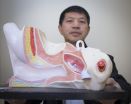Researcher detects traces of HIV in the city
Sociologist Gabriel Girard reveals the influence of HIV on the urban landscape
2015-07-09
(Press-News.org) This news release is available in French.
Since the treatment has become available, HIV is often described as "undetectable" and the risk of transmission has been drastically reduced. However, the epidemic is still quite present in the lives of many gay and bisexual men... and in public spaces. This often overlooked dimension of the disease has been brought to light by Gabriel Girard of the University of Montreal's Public Health Research Institute (IRSPUM) - HIV is still alive in the city, especially in the Village, Montreal's gay district. "Urban traces are significant as they shed light on the social and historical realities, in this case the realities of the HIV epidemic, at a time when AIDS is less present in the news," Girard explained. A sociologist and post-doctoral fellow, he presented his research on May 28 at the AMADES (Anthropologie Médicale Appliquée au Développement et à la Santé) conference in Ottawa.
Speaking on the theme "What cure means," Girard revealed significant and often overlooked traces of the disease in the urban landscape that resulted from community mobilization. "The most obvious example is Park of Hope, at the corner of Panet and Ste-Catherine Streets. The location owes its existence to a struggle by Act Up Montréal to create a place of commemoration and remembrance for those who died of AIDS in Quebec," he explained. "It took several years for the city to formalize the park's role in 1996." He also cited Raymond Blain Park, which, as noted by the plaque erected there, is named after a city councillor involved in the fight against the epidemic, who died of AIDS in 1992; and the creation of a mural at the corner of Wolfe and Ste-Catherine Streets, which displays a quote by Ron Fahra, who set up a foundation for men, women, and children living with HIV/AIDS.
The presence of HIV in the city is also linked to community and care organizations, which are numerous around the Village, such as the Actuel and Quartier Latin clinics, organizations such as RÉZO, and La Maison Plein Coeur. Other traces identified by Girard are less visible: "The Chapel of Hope, located in the Church of Saint-Pierre-Apôtre at the corner of Visitation and René-Levesque Streets, is a place of contemplation, and a flame has burnt there since July 22, 1996 in memory of the victims of AIDS," he said. Indeed, research into the urban traces of the disease also involved analyzing how public spaces have been reclaimed. "A vigil is held every year in Park of Hope on December 1, World AIDS Day. And in late September, the FARHA Foundation Walk mainly takes place in the streets of the Village. These two events are the only public events currently held in relation to AIDS in Montreal," Girard said.
His analysis intersects the history and presence of the gay and lesbian community in South Central Montreal with the history of mobilization against HIV. "The study involved considering a whole range of emotions reflected in these urban traces: anger and indignation, but also sadness and melancholy, which a place like Park of Hope incarnates in itself. But these vestiges of HIV in the neighbourhood also reflect hope, put into words by the mural's quotation - AIDS will disappear one day - which has special significance at a time of ongoing programs to eradicate the virus," Girard said. "Finally, the lasting marks of HIV also reflect nostalgia - for a changing neighbourhood, but also for a time when the gay community showed more solidarity in the fight against AIDS."
Current interest in this dark period of the epidemic, especially in cinema, is a positive development since it contributes to the collective memory of the gay, lesbian and transgender community. However, the researcher also feels that this nostalgia can obscure the complexities of the present situation. "It is the story of the homosexual mobilization against AIDS in the 1980s that is being written. Between fascination, passing the torch, and compassion, this story can sometimes efface the current issues of the epidemic. While the urgency is not the same in the North, there are still many problem areas, and we are never immune from setbacks to hard-won rights," he explained, while stressing that the "social geography of HIV deserves to be worked on more systematically."
INFORMATION:
[Attachments] See images for this press release:

ELSE PRESS RELEASES FROM THIS DATE:
2015-07-09
WEST LAFAYETTE, Ind. -- A key set of immune cells that protect the body from infection would be lost without directions provided by vitamin A, according to a recent study.
A team of researchers from Purdue University found retinoic acid, a metabolite that comes from digested vitamin A, is necessary for two of the three types of innate immune cells that reside in the intestine to find their proper place.
"It is known that vitamin A deficiencies lead to increased susceptibility to disease and low concentrations of immune cells in the mucosal barrier that lines the intestines," ...
2015-07-09
MADISON, Wis. -- A study authored by two University of Wisconsin-Madison graduate students indicates that while playing video games can improve mood, violent games may increase aggressive outcomes.
The study, authored by James Alex Bonus and Alanna Peebles, graduate students in Communication Arts, and Karyn Riddle, assistant professor in the School of Journalism and Mass Communication, was published in June in the journal Computers in Human Behavior. The researchers looked at how video games may be used to manage emotions -- specifically, whether playing the games can ...
2015-07-09
(Edmonton) Screening newborn babies who are in the neonatal intensive care unit (NICU) using a testing process called high-frequency tympanometry can help identify middle-ear problems earlier, according to newly published research from a local team of researchers.
"If people cannot hear, we need to know if the problem is with the middle ear, inner ear or hearing nerve. Obviously, a baby cannot tell you, so in the clinic it's hard to know when they have hearing loss," explained Ming Zhang, an associate professor at the U of A's Department of Communication Sciences and ...
2015-07-09
The relationship between mental and physical health is well established. But when mental and physical illnesses co-occur, patients' accounts of physical illness are sometimes arbitrarily discredited or dismissed by physicians.
Research by Jeremy D. Coplan, MD, professor of psychiatry at SUNY Downstate Medical Center, and colleagues has documented a high rate of association between panic disorder and four domains of physical illness. The research could alter how physicians and psychiatrists view the boundaries within and between psychiatric and medical disorders.
"Patients ...
2015-07-09
Green buildings are indeed healthy buildings. So says Dr. Joseph Allen and fellow researchers of the Harvard T.H. Chan School of Public Health in the US. They conducted the first comprehensive review of studies that focused on green buildings and summarized the health benefits for the people who work and live in them. The review is published in Springer's journal Current Environmental Health Reports.
The green building movement has taken off in the past 10 years. According to Leadership in Energy and Environmental Design (LEED®), which certifies green building standards, ...
2015-07-09
In about one-sixth of the cases of male infertility, men do not make any measurable levels of sperm, a condition called azoospermia. New research led by University of Pennsylvania scientists suggests that mutations in an X chromosome gene called TEX11 are responsible for about 1 percent of azoospermia cases.
The investigators also found that in mice bred to lack the gene, reintroducing the gene restores their fertility. Additional studies in mice revealed that a certain amount of the TEX11 protein expressed from the gene is needed for sperm to form. The protein plays ...
2015-07-09
An expert panel convened by the International Society for Sexual Medicine has developed a detailed "Process of Care" for the diagnosis and management of testosterone deficiency in men.
After an extensive literature review and in-depth consultations, the panel of 18 experts from a wide range of medical disciplines recommended that testosterone deficiency be defined as a clinical and biochemical syndrome characterized by both a deficiency of testosterone or testosterone action, and relevant symptoms. The panel stressed that the condition may affect multiple organ systems ...
2015-07-09
For the first time, a new analysis shows an impact of climate change on human society long before we knew the climate was actually changing.
Exploring Google's scanned book collection, the analysis finds that society in general increasingly discussed some of the predicted effects of climate change--such as heat waves, drought, and flooding--long before current global weather alterations were widely known about.
The authors note that while the science of climate change and climate action has come under sustained political attack, buttressing the physical record with ...
2015-07-09
A related package of articles published online by JAMA Oncology focuses on end-of-life care for teens and young adults and advance care planning for patients with cancer. The package of articles includes two original investigations, an invited commentary, an editorial, an accompanying editor's note and an author audio interview.
End-of-Life Care for Teens, Young Adults with Cancer
In the first study, corresponding author Jennifer W. Mack, M.D., M.P.H., of the Dana-Farber Cancer Institute, Boston, and her coauthors looked at the intensity of end-of-life care for teens ...
2015-07-09
In a review of nearly 2,000 surveys with people whose loved ones died of cancer, researchers led by Johns Hopkins experts say they found a 40 percent increase over a 12-year period in the number of patients with cancer who participated in one form of advance care planning -- designating durable power of attorney privileges to a loved one -- but no corresponding impact on their rates of aggressive medical care received in the last weeks of life.
In addition, the investigators say that despite the substantial increase in patients who designated a durable power of attorney, ...
LAST 30 PRESS RELEASES:
[Press-News.org] Researcher detects traces of HIV in the city
Sociologist Gabriel Girard reveals the influence of HIV on the urban landscape


